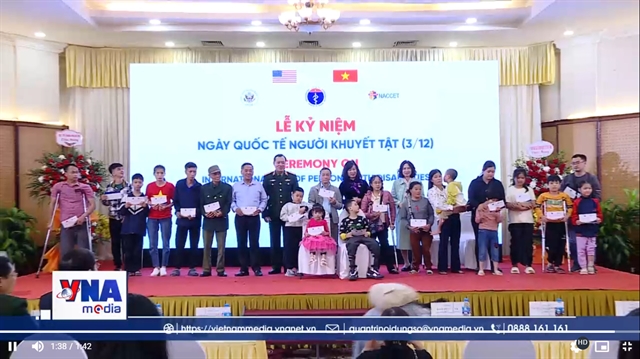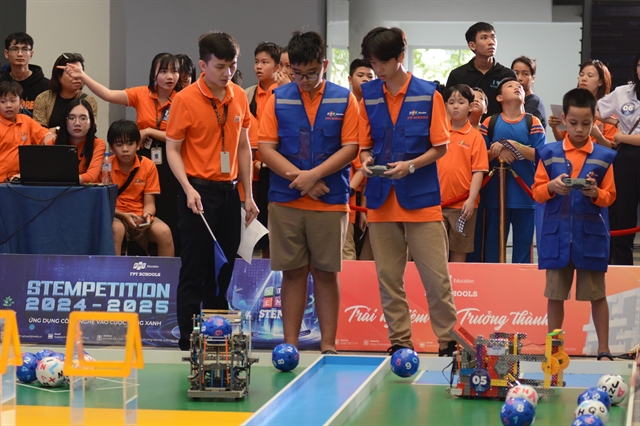 Society
Society

 |
| A high school team manoeuvres their robot in the Robot FPT Schools competition. — VNA/VNS Photo |
Việt Nam is facing mounting pressure to close serious gaps in its science and technology (S&T) workforce, as officials and experts warn that weaknesses in the quality and supply of skilled professionals could derail the country’s ambitions for innovation-led growth.
Despite recent progress, Việt Nam still falls short in producing enough capable researchers and engineers to meet rising demand, especially in key industries such as IT.
The Vietnam IT Market Report forecasts that by the end of this year, the country will need 700,000 new IT developers and engineers. However, universities and institutions are expected to provide around 500,000.
"The shortage of IT personnel is always the most difficult problem for the market. Although the salary and bonuses have been increasing remarkably for this industry, Việt Nam has had a shortage of 150,000 to 200,000 developers or engineers annually since 2023," the report said.
That shortfall is made worse by concerns over graduate readiness. Although about 50,000 students graduate with IT degrees each year, only about 30 per cent are considered job-ready. Most require additional training to meet real-world demands.
Experts say this reflects a broader mismatch between university curricula and the practical needs of the economy.
According to Mai Văn Hưng, a senior lecturer in natural sciences, although the country has around 30,000 PhDs, only a small proportion are actively conducting research.
While the quality of research has improved in recent years, it remains uneven across fields. Key sectors such as biotechnology, IT and human sciences still suffer from a shortage of experts, and the scarcity of well-established and professional research institutions.
Trần Tuấn Anh, vice president of the Vietnam Academy of Science and Technology, echoed these concerns.
Citing data from the Ministry of Science and Technology, Anh said that Việt Nam currently had about 75,665 full-time equivalent researchers, or about 7.68 per 10,000 people. That figure was well below its regional peers, such as Singapore, Malaysia and Thailand.
Most S&T talent was concentrated in Hà Nội and HCM City, while many other provinces lacked both numbers and quality in their research communities, he said.
At a national S&T conference in February, Prime Minister Phạm Minh Chính described S&T human resource development as 'top of the agenda'.
He underlined it as the key to restructuring Việt Nam’s economy, boosting productivity and increasing its global competitiveness. However, he also admitted that S&T workforce progress still fell short of expectations and the market needs.
According to Nguyễn Văn Thích, deputy dean of Business Administration at HCM City's University of Banking, a major part of the problem lies in inflexible training methods.
Education remains heavily theoretical, with limited emphasis on practical skills, creative thinking or independent research. As a result, graduates often fail to meet global standards.
Incentives for talent retention are also lacking. With modest salaries, limited promotion opportunities and underdeveloped research environments, many capable scientists choose to work in the private sector or leave the country altogether.
Thích also pointed to the weak links between universities, research institutes and businesses. This disconnection left many research efforts poorly aligned with the real needs of the market, while commercialising scientific discoveries remained a persistent challenge.
Public investment in research and development also remains low by international standards, according to Thích. Funding is tight, labs are under-equipped, and long-term projects often go unsupported. At the same time, complex bureaucratic procedures and slow funding disbursements dampen motivation among scientists and researchers.
In a bid to reverse these trends, Việt Nam has set a goal of having 40 to 50 of its S&T organisations ranked regionally or globally by 2030.
Experts say that if achieved, such recognition could generate substantial momentum for growth, not just in research, but across the broader economy.
Thích said globally ranked institutions would enhance Việt Nam’s standing in the international scientific community, while also helping attract foreign funding, scholarships, and collaboration with top universities and tech firms.
These organisations could also serve as centres for training elite researchers, building a new generation of scientists capable of driving national development.
"Increased international credibility also makes it easier to commercialise research and apply findings in real-world contexts," he said. "That, in turn, helps build a stronger knowledge economy."
Lecturer Hưng said structural changes were needed to raise research standards at home. Strong, well-funded research groups should be created and empowered to take risks, accepting even failure in pursuit of long-term breakthroughs.
He stressed the importance of recruiting top scientific talent in each field, warning against amateur or trend-driven approaches to research. Domestic scientific publishing also needed to be strengthened, so that local scientists could share their work without relying solely on foreign journals.
Hưng also cited his own work developing a research group focused on AI in education, which aims to train specialists who can help integrate digital tools into Việt Nam’s classrooms.
Vice President Anh agreed that new approaches were necessary. Việt Nam, he said, must invest in research infrastructure, promote interdisciplinary work, and integrate digital tools such as AI and big data. Curricula should be internationalised, with more focus on emerging fields like biotechnology, robotics, and advanced materials.
Crucially, he added, better links must be forged between academia, research, and industry, so that scientific discoveries could move more quickly from lab to market.
Việt Nam is encouraging the private sector to play a larger role. In December 2024, the ruling Communist Party issued a resolution, calling for advancements in S&T, innovation, and digital transformation.
The resolution set key targets: by 2030, the country should have 12 researchers per 10,000 people and dozens of globally recognised research organisations.
Nguyễn Thế Hùng, general director of Vinades, said that private businesses and committed entrepreneurs were an underused resource in this national effort.
He proposed strengthening career guidance at earlier stages, potentially starting in primary or secondary school, and designing training programmes in cooperation with the private sector.
If graduates enter the workforce ready to meet industry needs, companies would save on retraining costs, while universities demonstrate greater relevance and impact.
"Universities should work with businesses to identify specific talent needs and build short-term training modules accordingly," Hùng said. "This area is still being overlooked."
He encouraged schools to promote innovation and research more actively, saying such initiatives motivate students and build stronger links between education and enterprise.
But even as the country upgrades its research capacity, STEM enrolment remains worryingly low.
Lê Trường Tùng, chairman of the FPT University Board, urged policymakers to find ways to shift students’ preferences towards science and engineering.
He pointed to Việt Nam’s development of training programmes for the semiconductor industry, which are based on strict entry criteria. While high standards are important, he warned that overly tight restrictions could discourage the numbers needed to support large-scale industrial development.
"We should focus on quality at the output stage, not limit access at the input," he said. "Training for mass industry needs is not the same as training a small elite group."
He highlighted the need for a more supportive financial system for students - one that includes scholarships, credit policies, and affordable tuition.
Without adequate funding for higher education, he argued, the goal of building a high-quality workforce would remain out of reach. VNS


.jpg)

